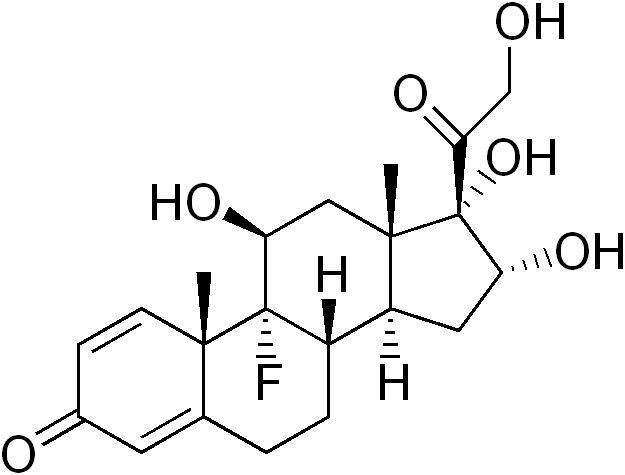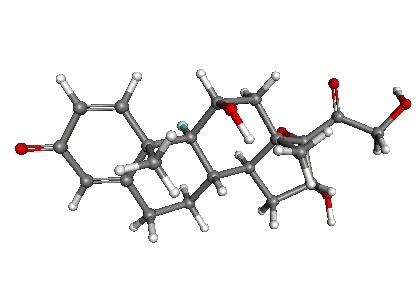Triamcinolone (topical)
Editor-In-Chief: C. Michael Gibson, M.S., M.D. [1]; Associate Editor(s)-in-Chief: Turky Alkathery, M.D. [2]
Disclaimer
WikiDoc MAKES NO GUARANTEE OF VALIDITY. WikiDoc is not a professional health care provider, nor is it a suitable replacement for a licensed healthcare provider. WikiDoc is intended to be an educational tool, not a tool for any form of healthcare delivery. The educational content on WikiDoc drug pages is based upon the FDA package insert, National Library of Medicine content and practice guidelines / consensus statements. WikiDoc does not promote the administration of any medication or device that is not consistent with its labeling. Please read our full disclaimer here.
Overview
Triamcinolone (topical) is a long-acting synthetic corticosteroid that is FDA approved for the treatment of inflammatory and pruritic manifestations of corticosteroid-responsive dermatoses. Common adverse reactions include burning, itching, irritation, dryness, folliculitis and hypertrichosis.
Adult Indications and Dosage
FDA-Labeled Indications and Dosage (Adult)
Indications
- Topical corticosteroids are indicated for the relief of the inflammatory and pruritic manifestations of corticosteroid-responsive dermatoses.
Dosage
- Topical corticosteroids are generally applied to the affected area as a thin film from two to four times daily depending on the severity of the condition. Occlusive dressing may be used for the management of psoriasis or recalcitrant conditions.
If an infection develops, the use of occlusive dressing should be discontinued and appropriate antimicrobial therapy instituted.
Off-Label Use and Dosage (Adult)
Guideline-Supported Use
There is limited information regarding Off-Label Guideline-Supported Use of Triamcinolone (topical) in adult patients.
Non–Guideline-Supported Use
There is limited information regarding Off-Label Non–Guideline-Supported Use of Triamcinolone (topical) in adult patients.
Pediatric Indications and Dosage
FDA-Labeled Indications and Dosage (Pediatric)
There is limited information regarding Triamcinolone (topical) FDA-Labeled Indications and Dosage (Pediatric) in the drug label.
Off-Label Use and Dosage (Pediatric)
Guideline-Supported Use
- There is limited information regarding Off-Label Guideline-Supported Use of Triamcinolone (topical) in pediatric patients.
Non–Guideline-Supported Use
- There is limited information regarding Off-Label Non–Guideline-Supported Use of Triamcinolone (topical) in pediatric patients.
Contraindications
- Topical corticosteroids are contraindicated in those patients with a history of hypersensitivity to any of the components of the preparations.
Warnings
Precautions
General
- Systemic absorption of topical corticosteroids has produced reversible hypothalamic-pituitary-adrenal (HPA) axis suppression, manifestations of Cushing's syndrome, hyperglycemia, and glucosuria in some patients.
- Conditions which augment systemic absorption include the application of the more potent steroids, use over large surface areas, prolonged use, and the addition of occlusive dressings. Therefore, patients receiving a large dose of a potent topical steroid applied to a large surface area or under an occlusive dressing should be evaluated periodically for evidence of HPA axis suppression by using the urinary free cortisol and ACTH stimulation tests. If HPA axis suppression is noted, an attempt should be made to withdraw the drug, to reduce the frequency of application, or to substitute a less potent steroid.
- Recovery of HPA axis function is generally prompt and complete upon discontinuation of the drug. Infrequently, signs and symptoms of steroid withdrawal may occur, requiring supplemental systemic corticosteroids. Children may absorb proportionally larger amounts of topical corticosteroids and thus be more susceptible to systemic toxicity (see PRECAUTIONS-PEDIATRIC USE).
- If irritation develops, topical corticosteroids should be discontinued and appropriate therapy instituted. In the presence of dermatological infections, the use of an appropriate antifungal or antibacterial agent should be instituted. If a favorable response does not occur promptly, the corticosteroid should be discontinued until the infection has been adequately controlled.
Adverse Reactions
Clinical Trials Experience
- The following local adverse reactions are reported infrequently with topical corticosteroids, but may occur more frequently with the use of occlusive dressings. These reactions are listed in an approximate decreasing order of occurrence: burning, itching, irritation, dryness, folliculitis, hypertrichosis, acneiform eruptions, hypopigmentation, perioral dermatitis, allergic contact dermatitis, maceration of the skin, secondary infection, skin atrophy, striae and miliaria.
Postmarketing Experience
There is limited information regarding Triamcinolone (topical) Postmarketing Experience in the drug label.
Drug Interactions
There is limited information regarding Triamcinolone (topical) Drug Interactions in the drug label.
Use in Specific Populations
Pregnancy
- Corticosteroids are generally teratogenic in laboratory animals when administered systemically at relatively low dosage levels. The more potent corticosteroids have been shown to be teratogenic after dermal application in laboratory animals. There are no adequate and well-controlled studies in pregnant women on the teratogenic effects from topically applied corticosteroids. Therefore, topical corticosteroids should be used during pregnancy only if the potential benefit justifies the potential risk to the fetus. Drugs of this class should not be used extensively on pregnant patients, in large amounts, or for prolonged periods of time.
Pregnancy Category (AUS):
There is no Australian Drug Evaluation Committee (ADEC) guidance on usage of Triamcinolone (topical) in women who are pregnant.
Labor and Delivery
There is no FDA guidance on use of Triamcinolone (topical) during labor and delivery.
Nursing Mothers
- It is not known whether topical administration of corticosteroids could result in sufficient systemic absorption to produce detectable quantities in breast milk. Systemically administered corticosteroids are secreted into breast milk in quantities not likely to have a deleterious effect on the infant. Nevertheless, caution should be exercised when topical corticosteroids are administered to a nursing woman.
Pediatric Use
- Pediatric patients may demonstrate greater susceptibility to topical corticosteroid-induced HPA axis suppression and Cushing's syndrome than mature patients because of a larger skin surface area to body weight ratio.
- Hypothalamic-pituitary-adrenal (HPA) axis suppression, Cushing’s syndrome, and intracranial hypertension have been reported in children receiving topical corticosteroids. Manifestations of adrenal suppression in children include linear growth retardation, delayed weight gain, low plasma cortisol levels, and absence of response to ACTH stimulation. Manifestations of intracranial hypertension include bulging fontanelles, headaches, and bilateral papilledema.
- Administration of topical corticosteroids to children should be limited to the least amount compatible with an effective therapeutic regimen. Chronic corticosteroid therapy may interfere with the growth and development of children.
Geriatic Use
There is no FDA guidance on the use of Triamcinolone (topical) in geriatric settings.
Gender
There is no FDA guidance on the use of Triamcinolone (topical) with respect to specific gender populations.
Race
There is no FDA guidance on the use of Triamcinolone (topical) with respect to specific racial populations.
Renal Impairment
There is no FDA guidance on the use of Triamcinolone (topical) in patients with renal impairment.
Hepatic Impairment
There is no FDA guidance on the use of Triamcinolone (topical) in patients with hepatic impairment.
Females of Reproductive Potential and Males
There is no FDA guidance on the use of Triamcinolone (topical) in women of reproductive potentials and males.
Immunocompromised Patients
There is no FDA guidance one the use of Triamcinolone (topical) in patients who are immunocompromised.
Administration and Monitoring
Administration
There is limited information regarding Triamcinolone (topical) Administration in the drug label.
Monitoring
There is limited information regarding Triamcinolone (topical) Monitoring in the drug label.
IV Compatibility
There is limited information regarding the compatibility of Triamcinolone (topical) and IV administrations.
Overdosage
- Topically applied corticosteroids can be absorbed in sufficient amounts to produce systemic effects (see PRECAUTIONS).
Pharmacology
Mechanism of Action
There is limited information regarding Triamcinolone (topical) Mechanism of Action in the drug label.
Structure
There is limited information regarding Triamcinolone (topical) Structure in the drug label.
Pharmacodynamics
There is limited information regarding Triamcinolone (topical) Pharmacodynamics in the drug label.
Pharmacokinetics
There is limited information regarding Triamcinolone (topical) Pharmacokinetics in the drug label.
Nonclinical Toxicology
Carcinogenesis, Mutagenesis, Impairment of Fertility - Long-term animal studies have not been performed to evaluate the carcinogenic potential or the effect on fertility of topical corticosteroids.
Studies to determine mutagenicity with prednisolone and hydrocortisone have had negative results.
Clinical Studies
There is limited information regarding Triamcinolone (topical) Clinical Studies in the drug label.
How Supplied
Triamcinolone Acetonide Cream USP, 0.025% is available as follows:
15 g tube (NDC 45802-063-35)
80 g tube (NDC 45802-063-36)
454 g jar (NDC 45802-063-05)
Triamcinolone Acetonide Cream USP, 0.1% is available as follows:
15 g tube (NDC 45802-064-35)
80 g tube (NDC 45802-064-36)
454 g jar (NDC 45802-064-05)
Triamcinolone Acetonide Cream USP, 0.5% is available as follows:
15 g tube (NDC 45802-065-35)
Storage
Store at 20-25°C (68-77°F) [see USP Controlled Room Temperature].
Images
Drug Images
{{#ask: Page Name::Triamcinolone (topical) |?Pill Name |?Drug Name |?Pill Ingred |?Pill Imprint |?Pill Dosage |?Pill Color |?Pill Shape |?Pill Size (mm) |?Pill Scoring |?NDC |?Drug Author |format=template |template=DrugPageImages |mainlabel=- |sort=Pill Name }}
Package and Label Display Panel
{{#ask: Label Page::Triamcinolone (topical) |?Label Name |format=template |template=DrugLabelImages |mainlabel=- |sort=Label Page }}
Patient Counseling Information
Patients using topical corticosteroids should receive the following information and instructions:
1. This medication is to be used as directed by the physician. It is for external use only. Avoid contact with the eyes.
2. Patients should be advised not to use this medication for any disorder other than for which it was prescribed.
3. The treated skin area should not be bandaged or otherwise covered or wrapped as to be occlusive unless directed by the physician.
4. Patients should report any signs of local adverse reactions especially under occlusive dressing.
5. Parents of pediatric patients should be advised not to use tight-fitting diapers or plastic pants on a child being treated in the diaper area, as these garments may constitute occlusive dressings.
Precautions with Alcohol
Alcohol-Triamcinolone (topical) interaction has not been established. Talk to your doctor about the effects of taking alcohol with this medication.
Brand Names
There is limited information regarding Triamcinolone (topical) Brand Names in the drug label.
Look-Alike Drug Names
There is limited information regarding Triamcinolone (topical) Look-Alike Drug Names in the drug label.
Drug Shortage Status
Price
References
The contents of this FDA label are provided by the National Library of Medicine.

